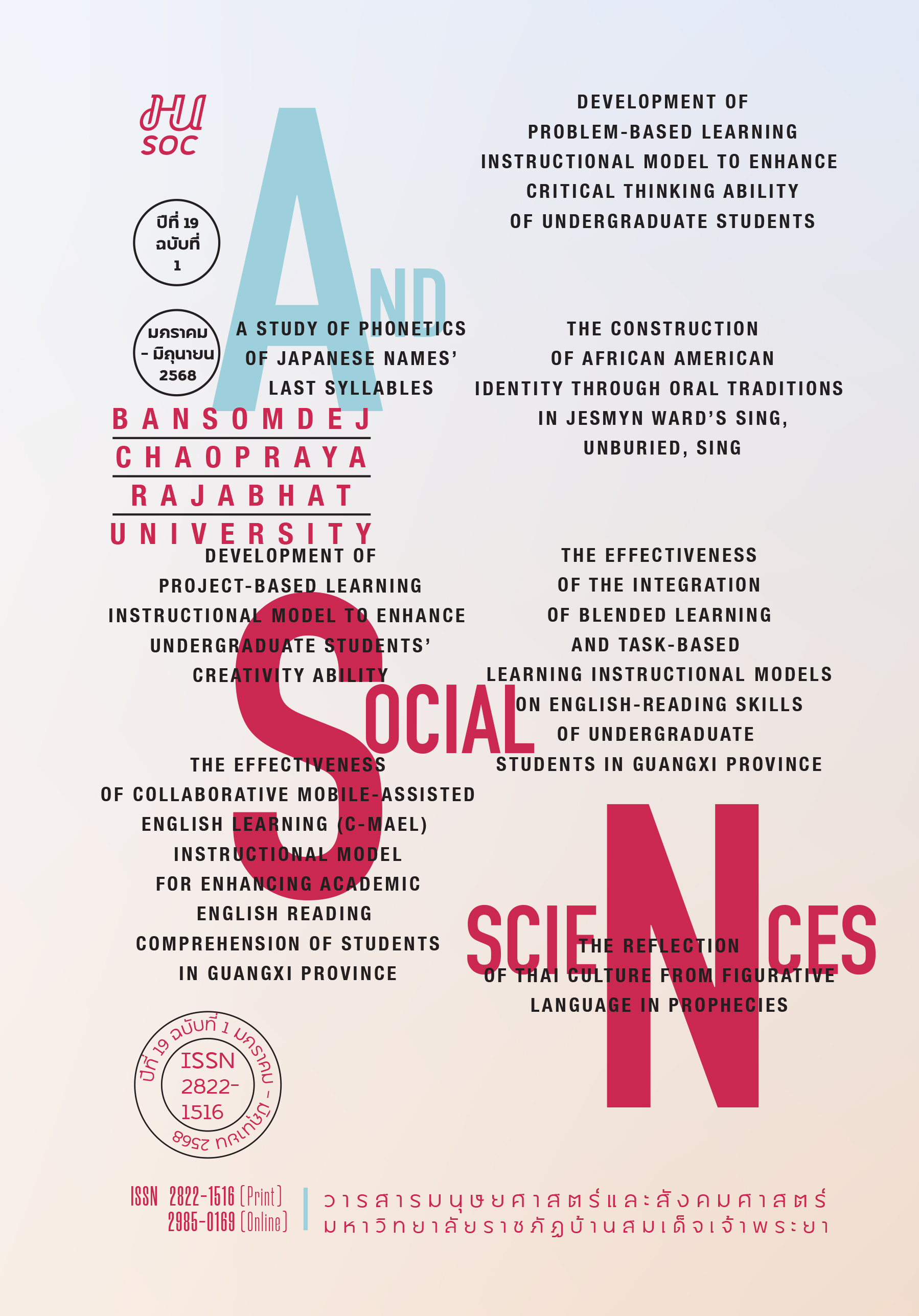The Reflection of Thai Culture through Figurative Language in Prophecies
คำสำคัญ:
Language and Culture, Figurative Language, Thai Culture, Propheciesบทคัดย่อ
The current study examines how figurative language including simile, metaphor, personification, hyperbole, and metonymy in prophecies reflects Thai culture. This study employed a non-probable sampling method. The data collection was 68 prophecies from Rai Khing and Thai Samakkhi temples, Thailand. The framework of data analysis follows Closton (2015) and Saralamba (2021). To ensure the reliability and validity of the data analysis, three linguists were instructed to check the accuracy of the data analysis. The results of the study show that the figurative language written in the prophercies reflects Thai culture by comparing people with entities such as boats, chickens, fish, and flowers. However, the figurative language in prophecies is always used when the writers convey a message with a negative connotation. It is expected that the results of this study will be beneficial for learners of English as a Foreign Language so as to gain better understanding about language and culture. The study contributes to business English in that the use of language in temples is intertwined with marketing techniques. After reading prophecies, financial donation is given because of the better life in the future.
เอกสารอ้างอิง
Afriyuninda, E., & Oktaviani, L. (2021). The use of English songs to improves English’s listening skills. Journal of English Language Teaching and Learning, 2(2), 80-85.
Claridge, C. (2010). Hyperbole in English: A corpus-based study of exaggeration. Cambridge University Press.
Closton, H. L. (2015). Using figurative language. Cambridge University Press.
Dane, B. (2000). Thai women: Meditation as a way to cope with AIDS. Journal of Religion and Health, 39, 5-21.
Dobrovol’skij, D., & Piirainen, E. (2021). Figurative language: Cross-cultural and crosslinguistic perspectives. Walter de Gruyter.
Fadaee, E. (2010). Symbols, metaphor and similes in literature: A case study of “Animal Farm”. English and literature, 2(2), 19-27.
Fishbach, A., & Woolley, K. (2022). The structure of intrinsic motivation. Annual Review of Organizational Psychology and Organizational Behavior, 9(1), 339-363.
Hong, S. C. (2020). A cross-cultural study of the spiral of silence Theory with individualism-collectivism and uncertainty-avoidance. The Journal of the Korea Contents Association, 20(3), 286-297.
Jackson, J. (2014). Introducing language and intercultural communication. Routledge.
Jitmart, C., & Wongkittiporn, A. (2021). Figurative language used by an American singer: A case study of Lauv’s songs. Proceeding in RSU International Research Conference. Rangsit University. 48-56.
Knowles, M., & Moon, R. (2004). Introducing metaphor. Routledge.
Mahavarakorn, S. (2012). The moon: the conveyance of wisdom in the Jataka-Atthkatha. Institute of Culture and Arts Journal Srinakharinwirot University, 13(2), 76-83.
McCargo, D. (2008). Thailand: State of anxiety. Southeast Asian Affairs.
Namwong, J., Ketkaew, N. & Wongkittiporn, A. (2023). A study of figurative language in love songs. Proceeding in RSU International Research Conference. Rangsit University. 87-95.
Neuliep, J. W. (2016). Intercultural communication: A contextual approach. Sage Publications.
Phongphio, T. (2021). Tracing cultural values in Thai students’ dialogical argumentation. Education Quarterly Reviews, 4(3), 322-333.
Saralamba, C. (2021). A comparison of HUMANS ARE ANIMALS conceptual metaphor between English and Thai. Language and Linguistics, 39(1), 128-150.
Sayakhan, N. I. (2018). The use of personification and apostrophe as facilitators in teaching poetry. Journal of Language Studies, 1(4), 176-189.
Tangtrakarpong, N. (2015). King Naresuan’s fighting rooster registered as intangible cultural heritage in B.E. 2014. Rajabhat J. Sci. Humanit. Soc. Sci, 16(1), 10-19.
ดาวน์โหลด
เผยแพร่แล้ว
รูปแบบการอ้างอิง
ฉบับ
ประเภทบทความ
สัญญาอนุญาต
ลิขสิทธิ์ (c) 2024 คณะมนุษยศาสตร์และสังคมศาสตร์ มหาวิทยาลัยราชภัฏบ้านสมเด็จเจ้าพระยา

อนุญาตภายใต้เงื่อนไข Creative Commons Attribution-NonCommercial-NoDerivatives 4.0 International License.




